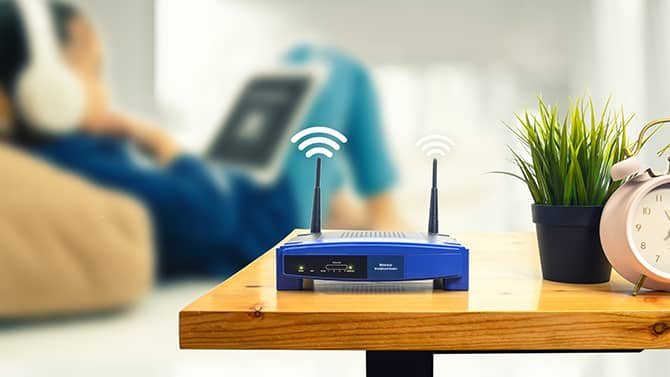In today’s interconnected world, a fast and stable Wi-Fi connection has become a must-have for every home. A stable home network ensures smooth operation of all your daily tasks, from watching 4K video to working from home and controlling smart home devices. However, many people struggle with weak signals, inconsistent speeds, and dropped connections. To address these issues, you need to understand the basics of home networking and use proven methods to improve your network. In this tutorial, we’ll introduce you to several reliable, research-backed methods for boosting Wi-Fi performance, expanding coverage, and delivering a smooth internet experience throughout your home. By following these expert tips, you’ll transform your Wi-Fi network into a powerful connectivity platform that quickly and easily supports all your digital needs.
Optimize Router Placement for Maximum Coverage
The first step to creating a strong Wi-Fi network is placing your router in the right place. Many people place their routers in corners or behind furniture, making it difficult for the signal to reach the rest of the house. Wi-Fi signals tend to radiate in all directions. For optimal coverage, place the router high and centrally, away from walls, metal objects, and other electronic devices that can cause interference. Avoid placing the router near microwaves, cordless phones, or baby monitors, as these devices use similar frequencies and can disrupt the signal. If your home has multiple floors, place the router on a middle floor or mount it on the wall for better coverage, both upstairs and downstairs. Remember that a clear line of sight is crucial. The fewer obstacles between the router and your devices, the better and more stable the connection.
Upgrade to the Latest Wi-Fi Standards
Technology is constantly evolving, and using an older router can degrade your network performance. Modern routers with Wi-Fi 6 or Wi-Fi 6E technology offer faster speeds, greater capacity, and better performance compared to older models. These high-tech routers can handle multiple connections simultaneously, ensuring your streaming, gaming, and smart home devices run smoothly and lag-free. If your router is older than three years, it might be time to replace it. Invest in a dual-band or tri-band router so your devices can connect to less congested frequencies. This device reduces interference and speeds up data transfer. With the latest standards, you’ll enjoy a faster and more reliable connection that meets the demands of a modern digital lifestyle.
Secure Your Network for Optimal Performance
Protecting personal data is just one part of network security; it also directly impacts performance. People who shouldn’t be using an unsecured network can hog your bandwidth and slow down your internet speed. Always use strong WPA3 encryption and set a unique, hard-to-guess password for your Wi-Fi network. To ensure your router’s security, disable WPS (Wi-Fi Protected Setup) and ensure you update your router’s firmware regularly. Many routers have built-in parental controls and firewalls to protect your home from threats. You can also create a guest network to isolate guest devices from the main network, keeping it running smoothly and securely. A well-secured network keeps your data private and provides maximum bandwidth to legitimate users, making their browsing experience faster and more secure.
Use Mesh Networks for Complete Home Coverage
Traditional routers often don’t provide reliable coverage in larger homes or multi-story spaces. This is where a mesh network system comes in handy. A mesh system connects multiple nodes into one seamless network that covers your entire home. Each node communicates with the others to eliminate dead zones and ensure your devices automatically connect to the strongest signal. While Wi-Fi extenders typically create separate networks, mesh systems use a single SSID, making them easier to connect. Google Nest, Netgear Orbi, and TP-Link Deco are excellent brands that allow you to easily set up and manage your network via mobile apps. With mesh systems, you can easily roam throughout your entire home without signal loss or lag.
Reduce Interference and Optimize Channels
Interference from nearby networks and devices in your home can negatively impact Wi-Fi performance. To reduce interference, you can see which channels are the most congested in your router’s admin panel. On most routers, you can select a less congested channel or use the automatic optimization feature. Channels 1, 6, and 11 are generally the best choices for the 2.4 GHz spectrum because they don’t overlap. The 5 GHz and 6 GHz bands, on the other hand, offer more channels and higher speeds, making them ideal for high-performance applications. Also, make sure your Wi-Fi isn’t on the same frequency as Bluetooth devices, baby monitors, or cordless phones. Fine-tuning the channel can significantly improve signal clarity and network performance.
Update Firmware and Optimize Device Settings
The firmware on your router affects how it works with other devices. To keep it working optimally, you should update it regularly. Manufacturers release updates that make your network faster, more secure, and more stable. You can regularly check for updates through your router’s admin panel or, if possible, set the firmware to update automatically. Furthermore, make sure the drivers on your laptop, phone, and tablet are up to date. You can adjust parameters like Quality of Service (QoS) as needed to provide more bandwidth for streaming, gaming, or videoconferencing. By continuously adjusting the settings on your router and devices, you ensure that your network continues to run smoothly, securely, and optimally.
Invest in High-Quality Ethernet Connections
Wi-Fi is flexible, but a wired connection remains the best way to get the fastest and most stable internet. If you want devices like game consoles, PCs, and smart TVs to always work, consider an Ethernet cable. Most modern routers have multiple LAN ports, allowing you to connect important devices directly. This technique not only increases productivity but also provides more wireless bandwidth for mobile and IoT devices. Powerline adapters or MoCA technology allow you to send data over your home’s electrical wiring or coaxial cables, even allowing you to combine wired and wireless configurations. A hybrid network infrastructure ensures that every device performs optimally without overloading the wireless network.
Conclusion
In the era of smart homes and digital convergence, optimizing your Wi-Fi network has become a necessity. Whether you’re watching your favorite shows, working from home, or automating daily tasks with IoT devices, a well-designed home network makes connecting to the internet effortless. Here are some key home networking guidelines to keep your Wi-Fi network quick, stable, and future-proof, including upgrading hardware, securing your network, and managing interference. The effort you put in now will pay off in better performance, fewer problems, and a better digital experience for everyone in the home. In short, a well-optimized Wi-Fi configuration is essential for a truly connected modern home.
FAQs
1. Why is my Wi-Fi still slow after buying a new router?
Interference, outdated firmware, or incorrect router placement can all contribute to slow speeds. Make sure your router is centrally located in the room and has the latest firmware.
2. How often should I restart my router?
Restarting your router weekly can clear temporary data and speed up the entire system.
3. Does a mesh network system work as well as a Wi-Fi extender?
Extenders can help, but they usually form a separate network. A mesh network system, on the other hand, provides seamless coverage throughout the house.
4. What’s the difference between 2.4 GHz and 5 GHz Wi-Fi?
2.4 GHz has a longer range but slower speeds, while 5 GHz is faster at shorter distances.
5. How can I see which devices are connected to my Wi-Fi?
You can view all the devices connected to your network and remove those that shouldn’t be there by going to your router’s administration page or using the accompanying app.




